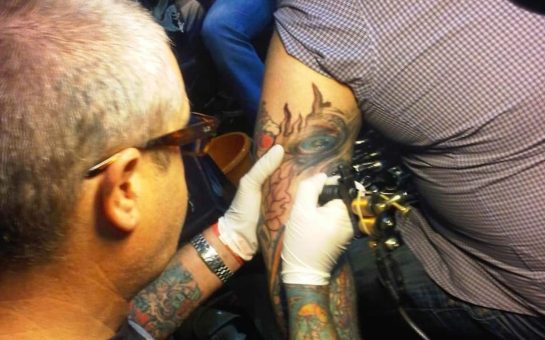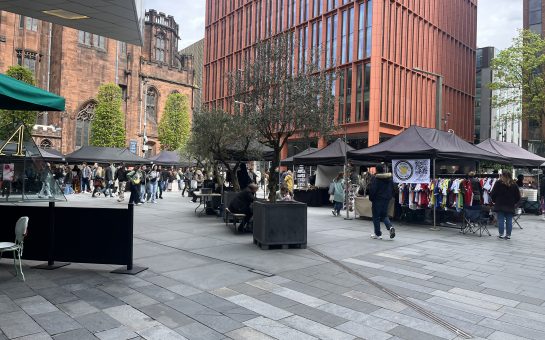‘What a waste’. That’s what they say whenever anyone speaks about the late Amy Winehouse. Only two albums in and she was snatched from this world continues the lament.
From the mouths of her family, friends, co-workers, hangers-on and staff pour words retelling, but not reshaping, the narrative sold with such relish in the early noughties.
From even the earliest and grainiest footage, her voice, crooning and amazing from the beginning, rings out.
in a weird/emo headspace after the Amy Winehouse doc last night…also cant stop listening to this mix: https://t.co/Mt8Wc056n5. #AmyForever
— Annie Terracina (@AnnieTerracina) July 1, 2015
Her ex-manager and friend, Nick Shymansky’s voice portrays a vivid, ‘gobby’ and funny girl who stumped interviewers and was openly contemptuous of those who misunderstood her meaning.
Her mother, Janis Winehouse, describes a ‘headstrong girl’ and all the while the pervading sense of gloom gathers.
This ‘gobby’ and ‘common’ London girl, so wide-eyed and naïve, is quickly shunted from the documentary’s limelight in favour of the events that unfolded.
Director, Asif Kapadia, spoke to ‘about a hundred people’ in the making of the two-hour film, finding new words for a story he admittedly didn’t know.
Comparing AMY with his previous documentary Senna he said: “We never found an expert, we didn’t know who that person was.”
Kapadia who ‘never met Amy’ and ‘never saw her live’ was the first to tempt Shymansky and Amy’s other long-time friends, Juliette Ashby and Lauren Gilbert into speaking about the jazz singer’s life.
Early footage of Amy, growing up in her teens let Kapadia show: “The young girl, the funny girl with the bright eyes.”
Keep on seeing these posters for the Amy Winehouse documentary everywhere. Breaks my heart every time. RIP Amy. pic.twitter.com/8vWBrpvWtC
— Jonny Benjamin (@MrJonnyBenjamin) June 22, 2015
For Shymansky, Kapadia’s team was the first to approach with a ‘serious’ interest in Amy’s life.
The film progresses and Amy’s sense of self and agency disappear shifting the focus to the outer forces impacting on her life: her fame, the press, drugs, her father and of course Blake.
The bass deepens as Amy’s ex-husband Blake Fielder (now Fielder-Civil) is introduced.
The lead up to AMY’s opening has been fraught with controversy with statements from both her father, Mitchell Winehouse and Blake Fielder-Civil claiming their portrayals were unfair and unflattering.
Unflattering to be sure.
Outright it is said that Blake introduced Amy to both heroin and crack cocaine. His slurring and mumbled voiceovers do him no favour either.
Every instance of Blake on screen is scored oppressively and edits become increasingly leading.
Amy Winehouse and Lana Del Rey hanging out. pic.twitter.com/DpXLnRdzmA
— ClassicPics (@History_Pics) June 25, 2015
Blake and Mitch are shown to be money-grabbing in their own ways.
Amy’s drug councillor describes her as Blake’s ‘gravy train’, whose money supplied both of their drug habits, lending credence to a long worn narrative about Amy being led astray.
Mitch circles Amy’s life taking an increasingly prominent position as her condition deteriorates.
Particularly damning are his own words that Amy did not need to go into rehab.
Forays to St Lucia with a camera crew filming My Daughter Amy make uncomfortable watching as Amy, who is meant to be getting clean, visibly shrinks from the camera.
Kapadia noted that Amy, once so forthright and welcoming of the lens, often holding it towards herself in early shots, became ‘more and more afraid of the camera’.
Increasingly distrustful of the camera the last act of the film is made up of footage, largely from the press, of paparazzi ‘brutally’ hounding Amy.
New Amy Winehouse painting coming to the penthouse might shut the game down #liveupdates pic.twitter.com/bysJ7nDnPH
— Tim Kelliher (@TKbluffs) June 22, 2015
This classic tale of a media feeding frenzy contributing a vulnerable star’s downfall plays out with those closest to her caught up in a swirling inertia of worry.
Leading up to the film’s finish, increasingly worried friends attempt to save Amy but their attempts are thwarted, several factors combine towards the documentary’s end.
Notably, Mitch Winehouse and Amy’s new manager Raye Cosbert’s insistence on her performing in her deteriorating state, seemingly pushed her back to drink.
Raye’s admission that he felt he didn’t need to be involved in Amy’s recovery is particularly coarse.
Years of bulimia and alcohol combine finally halting Amy’s spiral.
Little footage is devoted to the aftermath of Amy’s death. Memorable news images of fans leaving cans of Stella and cigarettes outside her home are obviously missing.
Few contributors come off well in this documentary. The exceptions being Amy’s long term friends who provided much of the early footage.
Amy Winehouse film director: ‘I wanted to show the fun, bright-eyed girl we didn’t know’. http://t.co/zRzjH4yG4A pic.twitter.com/DVMJs23Iqi
— * seregin_mma (@seregin_mma) July 1, 2015
Even Amy’s mother, devoted and loving no doubt, comes across as a figure who could do little but watch.
Four years on Amy is still drawing crowds and making money, her legacy will always be her music but her life is still under the scrutiny she despised.
Amy opens in cinemas on July 3 2015, tickets are available from HOME’s website.
Image courtesy of Fionn Kidney, with thanks.



